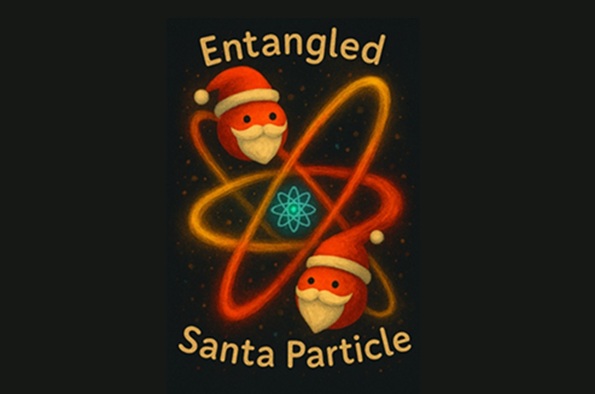
Science in the Snug: Santa An Entangled Particle
Start time: 18:30 / End time: 20:00 / Date: 04 Dec 2025 / Venue: School of the Arts Library, University of Liverpool, 19 Abercromby Square, L69 7ZG 19-23 Abercromby Square Open to: Any UOL students / Any UOL staff / University of Liverpool Alumni Type: Lecture Cost: FREE Contact: For more information contact Margaret Dzioba-Myszkowska at M.Dzioba@liverpool.ac.uk
About the event
📅 Date: Thursday 4 December 2025
🕒 Timings: Lecture begins at 6.30pm
📍Location: School of the Arts Library, University of Liverpool, 19 Abercromby Square, L69 7ZG
🎫 Tickets: FREE but spaces are limited! Secure your spot now.
Over the past ten years Professor Myers has developed his theory of Santa.
This first started by describing Santa in terms of a wave form and using Schrodinger’s wave equation to describe how it would be possible for Santa to deliver all the presents to all the children in the world in one day.
Through interactions with the audience attending the lectures and the developments in quantum mechanics over the past ten years the theory has changed and developed into today’s theory that describes Santa as an Entangled Particle.
This year Professor Myers will develop the entangled theory further by quoting the latest research on the space time theory and how this can be used to explain and expand the Santa Entanglement theory.
As in previous years Professor Myers will first point out the problems with a classical Santa.
Logistics: Delivering presents to millions of children worldwide in one night is a logistical nightmare. Even with the fastest reindeer, the time constraints are mind-boggling.
Physics: The idea of a sleigh flying through the sky, powered by reindeer, defies the laws of physics. Not to mention the speed required to visit every home would likely cause some serious aerodynamic issues.
Gift Production: The sheer volume of toys and gifts needed would require an enormous workforce and significant resources. The North Pole, as a remote and icy location, isn't exactly conducive to large-scale manufacturing.
Cultural Differences: Santa is a figure rooted in Western traditions. Explaining his presence in cultures with different gift giving customs and holiday traditions can be tricky.
Secrecy: Keeping such a massive operation secret from the world's population, especially in the age of social media and instant communication, is nearly impossible.
He will then guide the audience to think of Santa being a wave form and how as a wave some of the above problems can be solved; but not all. However, by describing Santa as an Entangled Particle, Santa would have:
Instantaneous Communication: With entanglement, Santa could instantly communicate with his elves and reindeer, no matter where they are. This would make coordinating
the delivery of presents a breeze.
Simultaneous Presence: Superposition would allow Santa to be in multiple places at once, delivering gifts to millions of homes simultaneously. No more worrying about time zones!
Efficient Data Processing: As a quantum computer, Santa could process vast amounts of data about children's wishes and behaviours in real time, ensuring that every gift is
perfectly matched to each child.
The "no-cloning" and "no-broadcast" theorems of quantum mechanics suggest that Santa would need to prepare unique quantum states for everyone. This also might be why every child gets a unique, tailored gift.
Introducing the latest research on space time Professor Myers will now explain some of the problem brought up after the last presentation, epically over the aging of Santa.
Add this event to my calendar
Click on "Create a calendar file" and your browser will download a .ics file for this event.
Microsoft Outlook: Download the file, double-click it to open it in Outlook, then click on "Save & Close" to save it to your calendar. If that doesn't work go into Outlook, click on the File tab, then on Open & Export, then Open Calendar. Select your .ics file then click on "Save & Close".
Google Calendar: download the file, then go into your calendar. On the left where it says "Other calendars" click on the arrow icon and then click on Import calendar. Click on Browse and select the .ics file, then click on Import.
Apple Calendar: The file may open automatically with an option to save it to your calendar. If not, download the file, then you can either drag it to Calendar or import the file by going to File >Import > Import and choosing the .ics file.